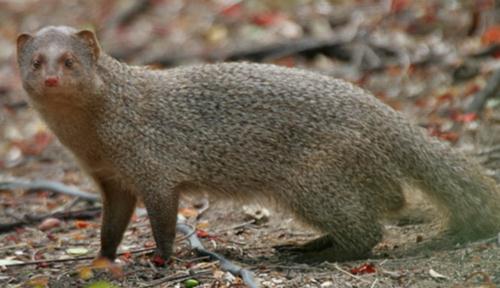Herpestes javanicus
Small Indian Mongoose
Synonym: Herpestes auropunctatus
Class: Mammalia
Order: Carnivora
Family: Herpestidae

Source: http://upload.wikimedia.org/wikipedia/commons/
Description
Mongooses are small mammals that resemble weasels; with slender bodies, short legs and a tail that makes up 40% of its total length. The narrow head had a pointed snout and short ears. The fur is brown with gold flecks and s paler on the belly than the backside. Their eyes are amber with body lengths ranging from 20-26 inches and they can weigh up to 2 pounds.
Ecological Threat: Herpestes javanicus is an opportunistic feeder that eats reptiles, amphibians, birds, invertebrates, plants, seeds, fruits and carrion (dead organisms). They are also known to eat eggs and have been considered responsible for damaging the populations of 4 different species of Sea Turtles; which all are endangers or threatened. The wide variety in diet makes them a huge threat to native species and a major deterrent to the recovery or reestablishment of island endemic animals. Native animals and plants on islands are more susceptible to extinction than animals on mainland continents. Controlling the Small Indian Mongoose is crucial if we want to maintain the beautiful and ecologically important native island plants and animals.
Biology: The time and length of breeding seasons varies with latitude but gestation is 49 days. Litter sizes ranges from 1 to 5 “pups” and at 6 weeks of age the young mongooses begin to hunt for their mothers. The pups stay with their mother until they are sexually mature at 4 to 6 months. Females may produce 2-3 litters a year and the life expectancy is 4-5 years.
History: The first successful introduction of mongooses to the Caribbean region was back in 1872. They were intentionally brought to the islands to control rats that were destroying sugarcane crop. From Jamaica, they were taken to other islands, between 1877 and 1879, Puerto Rico, St. Cr4iox and St. John for the same rat-control purpose. In 1883, Jamaican mongooses were imported by sugar growers on the Big Island of Hawaii, and then were later taken to the other Hawaiian Islands.
U.S. Habitat: In Puerto Rico and the U.S. Virgin Islands they are most abundant in drier habitats, but in Hawaii, they inhabit rainforests. In both, they could be found near human settlements.
Distribution
Native Origin: India and South Asia
U.S. Present: HI, PR and U.S. Virgin Islands
Management
Unlike India, Hawaii has no natural predators to the mongoose. Mongoose control must be done by humans, usually by trapping. However, very little animal control is going on. Avid management of these animals is the only way to start controlling their populations and reduce the bad influences they have on native fauna.
Text References
Coblentz, B., B. Coblentz. 1985. Control of the Indian Mongoose Herpestes auropunctatus on St John, US Virgin Islands. Biological Conservation 33: 281-288.
Hays, W. S., & Conant, S. 2007. Biology and impacts of Pacific Island invasive species. 1. A worldwide review of effects of the small Indian mongoose, Herpestes javanicus (Carnivora: Herpestidae). Pacific Science, 61(1):3-16.
Woodward, Susan L., and Joyce Ann. Quinn. 2011. Indian Mongoose. Encyclopedia of Invasive Species: From Africanized Honey Bees to Zebra Mussels. Santa Barbara, CA: Greenwood, 284-86. Print.
Internet Sources
http://www.instanthawaii.com/cgi-bin/hawaii?Animals.mongoose
http://animaldiversity.ummz.umich.edu/accounts/Herpestes_javanicus/
http://prgap.org/species/herpestes-javanicus/
 Texas Invasive Species Institute
Texas Invasive Species Institute